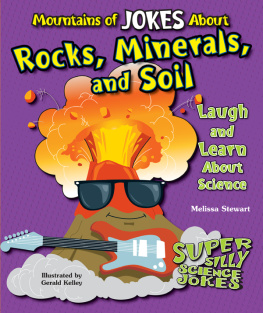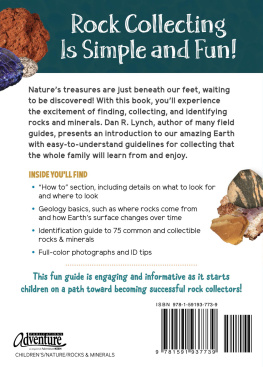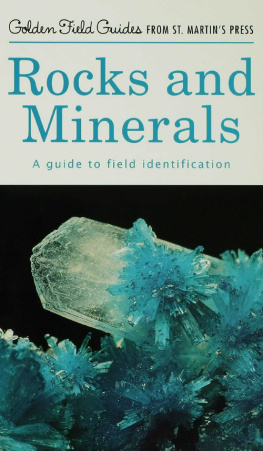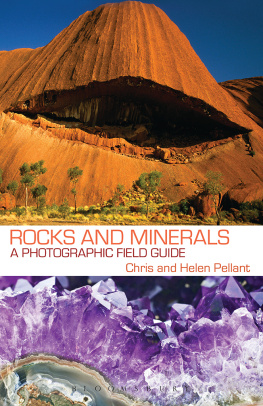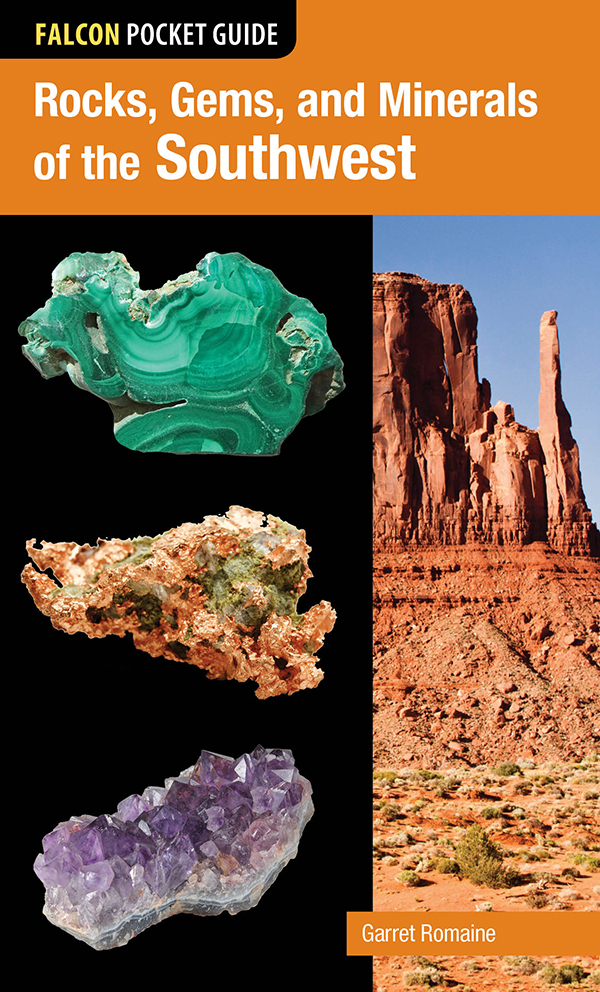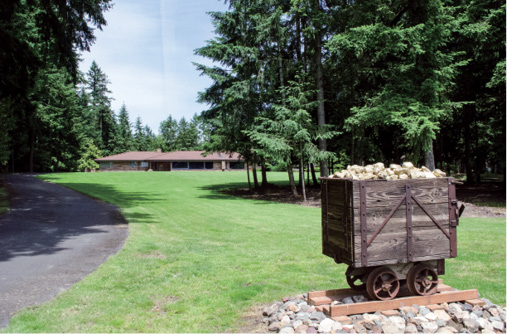Rocks, Gems, and Minerals of the Southwest
Garret Romaine
To my daughter Amy, forever my baby girl.
Copyright 2014 Morris Book Publishing, LLC
ALL RIGHTS RESERVED. No part of this book may be reproduced or transmitted in any form by any means, electronic or mechanical, including photocopying and recording, or by any information storage and retrieval system, except as may be expressly permitted in writing from the publisher. Requests for permission should be addressed to Globe Pequot Press, Attn: Rights and Permissions Department, PO Box 480, Guilford CT 06437.
FalconGuides is an imprint of Globe Pequot Press.
Falcon, FalconGuides, and Outfit Your Mind are registered trademarks of Morris Book Publishing, LLC.
Photos by Garret Romaine unless noted otherwise.
Project editor: Lynn Zelem
Text design: Sheryl P. Kober
Layout: Joanna Beyer
Library of Congress Cataloging-in-Publication Data is available on file.
ISBN 978-1-4930-1147-6
The author and Globe Pequot Press assume no liability for accidents happening to, or injuries sustained by, readers who engage in the activities described in this book.
Contents
Acknowledgments
Special thanks to Dr. Lara ODwyer-Brown, curator of the Rice Northwest Museum of Rocks and Minerals in Hillsboro, Oregon. The museum was founded in 1996 and originated with the extensive personal collection of rocks and minerals accumulated by Richard and Helen Rice. Starting with a few beach agates in 1938, the collection is now nationally recognized as one of the finest rock and mineral museums in the United States. The Rice family was especially interested in copper minerals from Arizona and the Southwest, creating a world-class exhibit of azurite, malachite, and more. Dr. ODwyer-Brown graciously allowed a small team of photographers access behind the velvet rope to take high-quality photographs for this guide, and I am very thankful to her for her patience.
Also, thanks to the following helpful friends and acquaintances: Rachel Houghton, veteran technical communicator and longtime friend from Portland, Oregon, who helped with photography, touch-up, editing, and encouragement; and Martin Schippers of KleurColor.com in Seattle, Washington, who also helped with photography touch-up.
Rice Northwest Museum of Rocks and Minerals
Introduction
About Geology
The term geology is a combination of two Greek expressions: Geo refers to the Earth, and logos refers to the logic and language used to explain your observations. So think of geology as a way to organize and explain the Earth processes that we see all around us. There are two key points to consider when trying to understand geology: time and entropy.
- Time. The Earth is a very young planet and thus still very active. But its also pretty old. Even though scientists have measured the Earth at 4.6 billion years old, thats young in the context of a 20-billion-year-old universe. Given enough time, a lot can happen on a young, geologically active planet. We have earthquakes, volcanoes, and moving continents. The forces that boil up from the Earths magnetic core are a long way from burning out, and they are relentless. Some activities happen quickly, like tsunamis, and theyre captured on film. Other forces take millions of years, leaving clues like all the mica flakes lined up in a schist. Good field observers can identify the obvious signs of things that seemed to happen before and apply those signs to the present and future.
- Entropy. Things fall apart all the time. Stuff happens. Storms rearrange coastlines and rework river channels. Earthquakes, volcanoes, windstorms, and floods all move mountains and leave scars that heal. A rock balanced precariously atop another rock will not remain for long; eventually, it will shake loose. The Earth is very efficient at recycling all that surface mayhem, hiding many clues. Mountains rise, then get ground down under glaciers and unrelenting rain. Tight chemical bonds that hold atoms together eventually weaken thanks to water, heat, pressure, and time. Oxygen in the air constantly rusts iron and dissolves minerals. Those forces are always at work and are easy to predict but hard to imagine sometimes. Try to picture the Mississippi River under flooding conditions that happen once every 100,000 years. Thats mayhem on a continental scale. Now imagine the resulting gravel bars as the river recedes from flood stage, and think about the possibility of being the first rockhound to check those newly stirred gravels.
Given enough time, almost anything can happen, and it usually does. We rarely see these processes at the surface, and we can only imagine what takes place at great depths. Thats where the logic comes in. There is a lot of math, chemistry, physics, biology, and just general science involved in sorting out whats going on in the field. But youre mostly interested in what you can see and collect, so read on.
Think in Series
We dont get a lot of absolutes in nature, so numbers, such as percentages of minerals present, help when thinking about crystal compositions. Just as there are probably no two snowflakes that are exactly alike, most granites differ in some way. Some basalts may have more iron and magnesium present, and some may have more feldspar. Some may have more magnesium and some more iron. You cant exactly tell without expensive equipment. And usually it doesnt really matter to that many decimals if you have a rough idea. You just want to collect the interesting forms, and you dont need a PhD in structural geology to dig out a seam of agate. You do need a hard hat, however.
Minerals are usually more straightforward than rocks because they tend to be more rigid in their chemistry. Sodium chloride, known as halite or rock salt, has one sodium atom and one chlorine atom. There isnt a lot of wiggle room there. You can get some potassium in the crystal lattice, substituting itself for sodium, but thats an impurity. You can get a little boron once in a while where chlorine should be, sometimes enough to haul out of the desert by mule team. Too many impurities, and the result will more likely be a different halide. Sedimentary rocks may seem uniform at first glance, but they are often composed of different bands of sand, silt, and clay. So think in terms of trending to one end of the scale or the other, and less in absolutes.
Field Studies
One big complication in identifying rocks and minerals is the tendency of the Earths atmosphere to oxidize everything. That same oxygen we need to breathe also wreaks havoc on fresh material. Oxygen ions are always looking to hook up with another ion, preferably a metal. Youve seen how a freshly sharpened knife blade starts to rust in the rain. That oxidation is also at work on cliff faces and boulders, aiding and abetting a tendency toward natural cracks, root action, freezing, and thawing. Many rocks get a reddish-brown surface in a short amount of time. First they turn color and then they fall apart.


